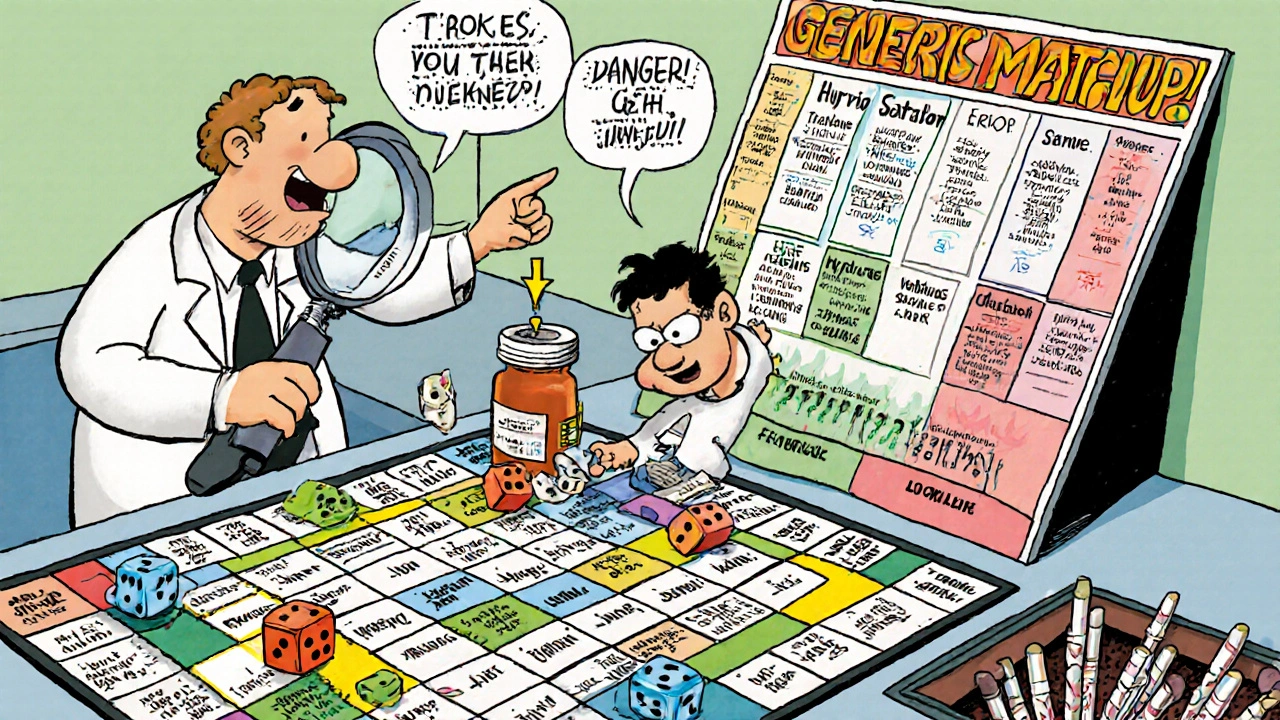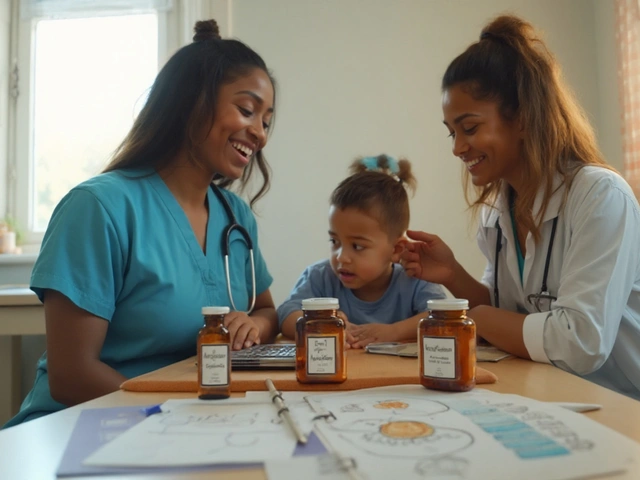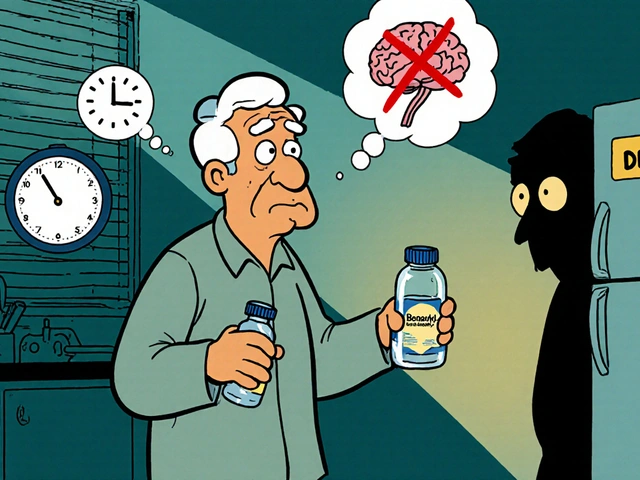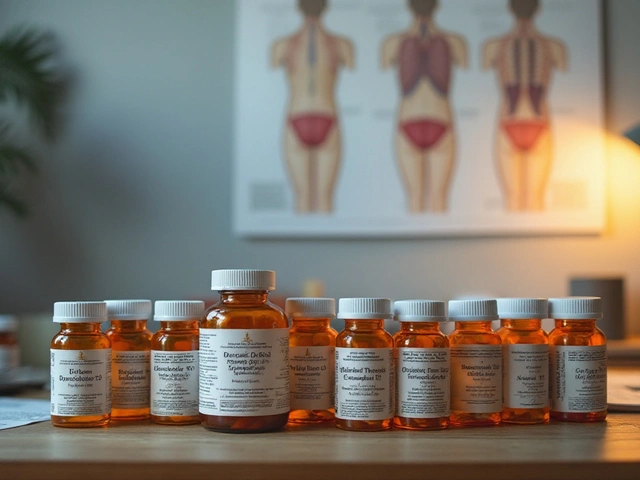When a pharmacy technician pulls a bottle off the shelf, they’re not just grabbing a pill-they’re handling a life-or-death decision. In the U.S., 90% of all prescriptions filled are for generic drugs. That means for every 10 medications dispensed, nine are not the brand name a patient might recognize. If a technician can’t confidently tell the difference between metformin and glipizide, or confuse hydroxyzine with hydralazine, the consequences aren’t theoretical. They’re deadly.
Why Generic Drug Knowledge Isn’t Optional
Generic drugs aren’t cheaper alternatives-they’re identical in active ingredients, strength, dosage form, and effectiveness to their brand-name counterparts. But they have different names, shapes, colors, and sometimes even different inactive ingredients. That’s where the risk lies. The Institute for Safe Medication Practices (ISMP) reports that 10-15% of medication errors tied to patient harm stem from confusion between generic and brand names. In 2021 alone, these errors contributed to about 7,000 deaths in the U.S. That’s not a statistic-it’s a system failure. And pharmacy technicians, who handle the physical dispensing of 80-90% of prescriptions, are on the front lines. It’s not enough to know that “the blue pill is for blood pressure.” You need to know that lisinopril is the generic for Prinivil and Zestril, that it comes in 5mg, 10mg, and 20mg tablets, and that it’s often confused with losartan because both end in “-pril” and “-artan.” That’s the level of precision required.What the Standards Actually Require
The Pharmacy Technician Certification Board (PTCB) sets the national baseline. Their 2026 certification exam now dedicates 18% of its content to generic drug knowledge-up from 14% just two years ago. That’s more than any other single topic. Technicians must be able to:- Match generic names to brand names for at least 200 of the most commonly prescribed drugs
- Identify therapeutic duplications-like prescribing both ibuprofen and naproxen together
- Recognize drug classifications: beta-blockers, statins, SSRIs, etc.
- Understand dosage forms: immediate-release vs extended-release, capsules vs tablets
- Know the physical appearance of high-risk medications: insulin pens, anticoagulants, opioids
How Training Works in Real Pharmacies
Most pharmacy technician programs start with the “Top 200 Drugs” list. That’s the industry standard. It’s not arbitrary-it’s based on CDC and FDA dispensing data. Programs like RxTechExam and PTCBTestPrep focus on these drugs because they represent over 75% of all prescriptions filled. But rote memorization doesn’t stick. The best training programs use active recall and grouping strategies:- By therapeutic class: Group all statins (atorvastatin, rosuvastatin, simvastatin) together. Learn their common suffixes-“-vastatin” means cholesterol-lowering.
- By appearance: Visual learners benefit from associating pills with color, shape, and imprint codes. A yellow, oval pill with “50” on one side? That’s metoprolol succinate ER.
- By risk: High-alert medications like insulin, heparin, and warfarin get extra attention. Mistakes here aren’t just errors-they’re emergencies.

What Happens When Standards Aren’t Met
The financial and human costs are staggering. The American Pharmacists Association estimates that inadequate generic drug knowledge costs the U.S. healthcare system $2.4 billion annually in avoidable hospitalizations, lawsuits, and wasted medications. One case from a community pharmacy in Ohio involved a technician dispensing glipizide (a diabetes drug) instead of glyburide (also for diabetes). Both are sulfonylureas. Both are round, white tablets. But glipizide is shorter-acting. The patient had a severe hypoglycemic episode and ended up in the ER. The pharmacy paid a $150,000 settlement. This isn’t rare. The ISMP tracks over 37 “look-alike, sound-alike” drug pairs that have caused serious harm. Others include:- Clonidine vs clonazepam (one lowers blood pressure, the other treats seizures)
- Hydralazine vs hydroxyzine (one is for hypertension, the other for anxiety)
- Levothyroxine vs levofloxacin (thyroid hormone vs antibiotic)
The Fast-Changing Landscape
The problem isn’t just memorization-it’s keeping up. The FDA approves 15-20 new generic drugs every month. In 2024, a technician certified in 2022 had to relearn 15 drugs because their manufacturers changed names or formulations. The VA responded by implementing mandatory quarterly competency assessments in January 2025. Technicians must now pass a random 100-drug test with 90% accuracy. If they fail, they’re pulled from dispensing duties until retrained. Community pharmacies are catching up. Walmart rolled out AI-powered drug identification training in 2024. New hires now complete a 2-week interactive module that simulates real dispensing scenarios. The result? A 35% drop in onboarding time and a 22% increase in accuracy scores. Even more telling: pharmacies that use barcode scanning still require technicians to recognize drugs visually. Because scanners fail. Power goes out. Labels get torn. Systems break. Human knowledge is the last line of defense.What Works: Real Stories from the Floor
Reddit’s r/pharmacytech community is full of hard-won wisdom. One tech, “PharmTech2020,” wrote: “I spent 8 weeks using flashcards and color-coded charts. I grouped drugs by their endings-‘-pril’ for ACE inhibitors, ‘-sartan’ for ARBs. Within a month, my error rate dropped in half.” Another, “GenericGuru,” swears by visual cues: “I don’t memorize names. I memorize looks. A white, round, scored tablet with ‘50’? That’s metoprolol. A green, oval, film-coated pill with ‘L 50’? That’s lisinopril. If I see it, I know it.” These aren’t tricks. They’re evidence-based strategies. A 2025 Pharmacy Times poll found that 68% of technicians who used visual association methods scored above 90% on generic drug exams-compared to just 41% who relied on pure memorization.
Where the System Still Falls Short
There’s a growing critique that current standards focus too much on names and not enough on understanding. Dr. Jerry Fahrni from the University of Minnesota argues: “If you know that atorvastatin is a statin, and statins reduce cholesterol by inhibiting HMG-CoA reductase, you don’t need to memorize every brand name. You can reason your way through it.” That’s the future. The ASHP’s 2025 curriculum update now includes “understanding biosimilar naming conventions”-a new frontier. Biosimilars aren’t generics. They’re complex biologic drugs with slightly different structures. Their names end in “-mab” or “-cept,” and their naming rules are still evolving. The real challenge? Keeping training dynamic. Right now, most study guides are printed annually. But drugs change monthly. The system needs real-time updates, not static lists.What You Can Do Today
If you’re a pharmacy technician:- Start with the PTCB’s Top 200 list. Master those first.
- Use color-coded flashcards. Group by class, not alphabet.
- Practice daily: Name 5 drugs by generic and brand before your shift.
- Know your high-alert drugs cold: insulin, heparin, warfarin, opioids, potassium chloride.
- Ask your pharmacist: “Why did they switch this to a generic?” Understanding the why builds retention.
- Replace outdated pocket guides with digital tools updated quarterly.
- Run monthly competency quizzes-randomized, timed, no notes.
- Use real error reports as teaching tools. Don’t punish mistakes-analyze them.
- Invest in AI-based training platforms. They’re cheaper than lawsuits.
Final Thought: It’s Not About Memory. It’s About Safety.
Generic drugs save patients money. But they don’t save lives unless the people handling them know exactly what they’re holding. The standards exist for a reason. They’re not bureaucratic hurdles-they’re safety nets. In a world where 9 out of 10 prescriptions are generic, your ability to distinguish between simvastatin and pravastatin isn’t just a skill. It’s a responsibility. And the only way to meet it is through disciplined, ongoing, real-world training.Why do pharmacy technicians need to know generic drug names?
Pharmacy technicians handle the physical dispensing of 80-90% of prescriptions, and 90% of those are generics. Confusing a generic name with a brand name-or two similar-sounding generics-can lead to serious medication errors. Knowing generic names ensures patients get the right drug, prevents therapeutic duplication, and supports safe substitution under state laws.
How many generic drugs should a pharmacy technician know?
The PTCB requires knowledge of at least 200 commonly prescribed medications by both generic and brand name. The VA and hospital settings often require mastery of 300+ drugs, especially high-alert medications like insulin, anticoagulants, and controlled substances. Most training programs focus on the Top 200 first, then expand based on practice setting.
Is memorizing drug names enough for competency?
No. While memorization is necessary, true competency comes from understanding drug classes and mechanisms. For example, knowing that drugs ending in “-pril” are ACE inhibitors helps you recognize new drugs even if you haven’t seen them before. Experts now recommend combining name recall with therapeutic reasoning to reduce errors by up to 30%.
How often do generic drug names change?
The FDA approves 15-20 new generic drugs every month. Manufacturers also change packaging, imprints, or even generic names in some cases. About 57% of technicians report having to relearn at least 5 drugs within 18 months of certification. This makes static study guides outdated quickly-ongoing training and digital updates are essential.
What’s the difference between generic and biosimilar drugs?
Generics are chemically identical copies of brand-name drugs. Biosimilars are highly similar-but not identical-to complex biologic drugs like insulin or cancer treatments. Their names have distinct suffixes (e.g., “-mab” for monoclonal antibodies), and they require additional training because they’re not interchangeable by default. The 2025 ASHP curriculum now includes biosimilar naming as a required competency.
Do all states have the same generic drug standards?
No. While all 50 states require pharmacy technicians to demonstrate generic drug knowledge, the specific requirements vary. California mandates knowledge of 180 drugs, Texas requires 120, and some states rely on the PTCB exam while others use the NHA’s ExCPT. This creates mobility challenges for technicians moving between states and highlights the need for national standardization.






Jessica Healey
November 17, 2025 AT 22:02I used to mix up hydralazine and hydroxyzine all the time-until I started labeling my flashcards with little doodles. Hydroxyzine? That’s the ‘itchy face’ pill. Hydralazine? That’s the ‘blood pressure down’ one. Now I can’t unsee it. Also, I cry every time I see someone miss a generic and the patient gets sent to the ER. It’s not just work-it’s life.
Levi Hobbs
November 19, 2025 AT 06:08Yes, yes, yes-this is so important. I’ve seen it firsthand: a technician once handed out glipizide instead of glyburide, and the patient ended up in the ICU. The pharmacy didn’t even catch it until the family called. We need mandatory visual recognition drills-not just multiple-choice quizzes. Also, color-coding by therapeutic class? Genius. I’ve started doing it with my team, and our error rate dropped 40% in three months. Let’s stop pretending memorization is enough.
henry mariono
November 20, 2025 AT 23:36It’s funny how we treat this like a test. It’s not. It’s a survival skill. I don’t care if you know the Top 200-if you can’t look at a pill and say ‘that’s metoprolol’ without checking the label, you shouldn’t be touching prescriptions. I’ve been doing this for 12 years. I still double-check insulin pens. Always. Because one mistake, and you’re not just fired-you’re haunted.
Sridhar Suvarna
November 21, 2025 AT 05:38From India, I’ve seen how generic drugs are the backbone of healthcare here too. But in our clinics, techs often rely on color and shape alone. No training. No standards. Your post is a wake-up call. We need global guidelines-not just American ones. Maybe the WHO should step in. This isn’t just a pharmacy issue-it’s a public health crisis. And it’s happening everywhere.
Joseph Peel
November 22, 2025 AT 09:26The VA’s quarterly 100-drug test is the gold standard. No excuses. No retakes unless you fail. And the AI training modules? Brilliant. I work at a Walmart pharmacy-we rolled them out last year. New hires go from terrified to confident in two weeks. The key? Real scenarios. Not flashcards. Not quizzes. Actual simulations where the pill bottle disappears and you have to identify it by imprint and color. That’s how you build muscle memory.
Kelsey Robertson
November 24, 2025 AT 02:33Oh, so now we’re all supposed to be pharmacists? Let me guess-next they’ll make us interpret ECGs and prescribe antibiotics. This is credential creep disguised as safety. Do you really think a tech needs to know the difference between simvastatin and pravastatin? Or are we just creating more hoops for underpaid workers to jump through so corporate can feel better about their profit margins? I’ve seen techs get fired for one mistake, while the pharmacist who didn’t double-check walks away scot-free. Hypocrisy.
Joseph Townsend
November 25, 2025 AT 11:23Y’all are acting like this is about memorizing pills. It’s not. It’s about not killing people. I’ve watched a guy get sent home with the wrong drug because the tech said, ‘It’s the blue one, right?’ And then the family called screaming because he was foaming at the mouth. That’s not a mistake-that’s a tragedy wrapped in a 9-to-5 shift. If you’re not crying when you read this, you’re not paying attention. And if you’re still using paper flashcards in 2025? You’re literally playing Russian roulette with lives.
Bill Machi
November 25, 2025 AT 12:02This is why America’s healthcare is a mess. We’re turning technicians into walking drug encyclopedias while our doctors are overworked and underpaid. Who’s to blame? The system. The corporations. The bureaucrats who think more rules = more safety. Newsflash: more rules just mean more paperwork. What we need is fewer drugs, better labeling, and pharmacists who actually supervise. Not another 18% on the PTCB exam. Just fix the damn system.
Elia DOnald Maluleke
November 25, 2025 AT 23:46Let us not forget: the human mind is not a database. It is a living instrument, shaped by context, emotion, repetition, and meaning. To reduce life-saving knowledge to flashcards and color-coding is to misunderstand the soul of healing. True competency arises not from rote recall, but from reverence-for the body, for the science, for the sacred weight of a single pill. The technician who holds that pill is not a clerk. She is a guardian. And the system that treats her as a machine is already dead.
satya pradeep
November 27, 2025 AT 08:37Bro I used to fail every quiz until I started grouping drugs by their endings--pril, -sartan, -vastatin. Now I can spot a drug by the shape alone. Also, insulin pens? I have a mental image of the cap color. Green = long-acting. Blue = rapid. No mistakes. And yeah, I’m from India-we don’t have fancy AI tools here. But we have grit. And if you’re still using paper lists in 2025? You’re doing it wrong. Try Anki. It’s free. It works.